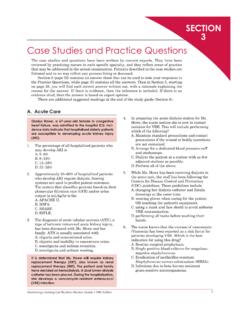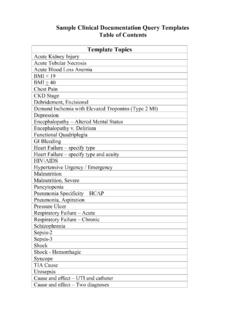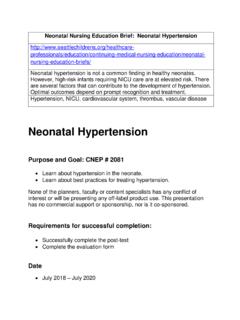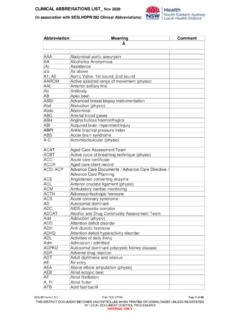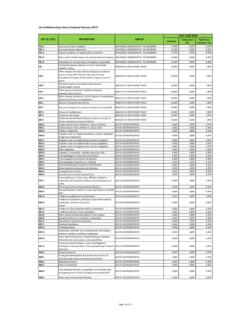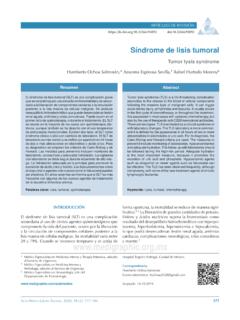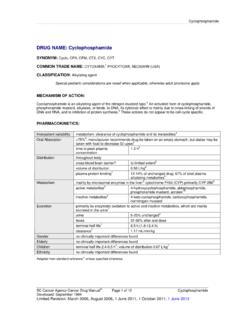Transcription of RENAL FAILURE: OLIGURIA, ANURIA: An Overview
1 RENAL FAILURE: OLIGURIA, ANURIA: An OverviewUniversity of PNGS chool of Medicine & Health Sciences, Discipline of Biochemistry & Molecular Biology, Clinical Biochemistry Lecture: BMSL III & BDS IV VJ TempleState some major functions of the kidneys? Regulation of Fluid Balance, Regulation of Electrolyte Balance, Regulation of Acid-Base Balance, Excretion of products of Protein & Nucleic Acid metabolism: Urea, Creatinine, Creatine, Uric Acid, Sulfate, Phosphate, etc. Endocrine Functions: Kidneys produce a number of hormones, and are under the control of other hormones;How can the functional state of the kidneys be assessed? To answer this question check your lecture on Investigation of RENAL Functions for detailsWhat do you understand by RENAL Failure? RENAL failure is the cessation of kidney function; RENAL Failure can be: acute or Chronic; acute RENAL Failure (ARF) is when the kidneys suddenly fail to carryout major functions, It can occur over a period of hours or days; Chronic RENAL Failure (CRF) develops over months or years and may lead to End Stage RENAL Failure (ESRF); CRF usually cause irreversible damage to the kidneys; ARF is reversible and normal RENAL Function can be regained; ARF can arise from a variety of problems affecting the kidneys and/or their blood circulation; ARF usually presents as a sudden deterioration of RENAL function indicated by rapidly rising: Serum urea concentration, and Serum creatinine concentration; Severely ill patients may develop ARF thus monitoring of kidney function is important in some groups of patients; What are the different phases of ARF?
2 Oliguric phases; Diuretic Phase; Recovery Phase;What are the Oliguric Phases? Oliguric phase (Oliguria): Urine output of patient falls to less than 400ml in 24hrs, Non-Oliguric phase (Non-Oliguria): Urine output of the patient is normal, Glomerular Filtration rate is low, Patient has tubular Dysfunction , Anuric phase (Anuria): Patients do not pass any urine, Within the first 24 hours of ARF: Serum and Urine tests for RENAL Function might not reveal any abnormality; What are some of the characteristics of Oliguric phase? Oliguria is mainly due to a fall in the GFR; In Oliguric phase: Urine Osmolality may be similar to that of Plasma, because: Level of Na+ions in urine is relatively high, Composition of the small amount of Glomerular Filtrate produced is only slightly altered by damaged Tubules; Na+ion conc. in Plasma may be low because of combination of factors: Intake of water in excess of the amount able to be excreted, Increase in metabolic water from increased tissue catabolism, A shift of Na+ions from ECF to (ICF); Plasma K+ion conc.
3 May be increased because of: Impaired RENAL output, and Increased tissue catabolism; Patient may develop metabolic acidosis because of failure to excrete H+ions and the increased formation of H+ions from tissue catabolism; Shift of K+ions out of cells accompanies the metabolic acidosis; Retention of: Urea, Creatinine, Phosphate, Sulfate and Other waste products occurs Rate of increase of urea in plasma depends on the rate of tissue catabolism, which depends on the cause of the ARF;How can the low urinary output in ARF be differentiated from Hypovolaemia? No specific lab tests are available to fully differentiate low urinary output of patient with suspected ARF from that due to severe circulatory impairment with reduced blood volume (Hypovolaemia); Careful assessment of fluid status of the patient, possibly including measurement of the central venous pressure, are required; See Table 1 INVESTIGATION OF A PATIENT WITH LOW URINE OUTPUT InvestigationSimple HypovolaemiaAcute RENAL FailureUrine Osmolality> 500mmol< 400mmolUrine [urea]:Plasma [urea]> 10mmol< 5 Urine [Na+]< 20mmol> 40mmolWhat lab parameters are used to monitor Oliguric phase?
4 For monitoringpatients in Oliguric phase of ARF: Very important parameters that must be determined at least once daily: Plasma Creatinine, Plasma Urea, and K+ion conc. are particularly important, For Fluid and Electrolyte replacement requirement, the following must be regularly assessed: Volume of urine and its Electrolyte composition; Volume and composition of any other measurable sources of fluid loss;DIURETIC PHASE With the onset of the Diuretic phase: Urine volume increases, Clearance of Urea, Creatinine and other waste products may not improve to the same extent, Plasma Urea and Creatinine levels may continue to rise, at least, at the start of the Diuretic phase; Loss of Electrolytes may occur in urine; this should be monitored and replaced as appropriate; Level of K+ions in plasma may fall as the diuretic phase continues, because of: Shift of K+ions back into the cells, and Increased losses in urine due to impaired regulation of K+ions by the damaged tubules; Loss of Na+ions may also occur because of failure of regulation by the damaged RENAL tubules.
5 During Diuretic phase, measure plasma: Creatinine, Urea, Na+and K+ions at least once daily, Monitor the urine flow rate and electrolyte output;How is ARF classified? Pre- RENAL : When blood supply to the kidneys is affected; May be due to vascular obstruction or to reduced perfusion; RENAL : When the kidneys are damaged; May be due to a variety of diseases, RENAL damage may be due to prolonged Pre or Post- RENAL problems; Post- RENAL : Problems occurring after the Kidneys, Urinary drainage of kidneys impaired by obstruction, May be due to RENAL Stones, Carcinoma of Cervix, Prostate, or Bladder;State some factors that can cause Pre- RENAL ARF Factors associated with reduced effective ECF Volume, may include: Decreased Plasma Volume because of: Blood loss, Burns, Prolonged Vomiting or Diarrhea, Diminished Cardiac Output; Local factors such as an Occlusion of RENAL Artery; Pre- RENAL factors may lead to: Decreased RENAL Perfusion, and Reduction in Glomerular Filtration Rate (GFR).
6 Both Arginine Vasopressin (AVP) and Aldosterone are secreted maximally and a small volume of concentrated urine is produced; State some Biochemical findings in patient with Pre- RENAL ARF? Serum Urea and Creatinine are increased: Urea is increased proportionally more than Creatinine because of its reabsorption by tubular cells at low urine flow-rates; Hyperkalemia due to decreased GFR and Acidosis; Metabolic Acidosis due to inability of Kidneys to excrete H+ions; High urine Osmolality;State some factors that can cause Post- RENAL ARF? Post- RENAL factors may cause decreased RENAL function, because: Effective Filtration pressure of Glomeruli is reduced due to back-pressure caused by obstruction; Obstruction may be caused by: RENAL Stones, Carcinoma of Cervix, Prostate or Occasionally Bladder; Failure to correct the Pre- RENAL or Post- RENAL factors can lead to Intrinsic RENAL damage ( acute tubular necrosis ); Patients in early stages of acute tubular necrosis may have only a modestly increased Serum Urea and Creatinine, which then rises rapidly over a period of days, in contrast to the slow increase over months and years seen in Chronic RENAL Failure; What are the biochemical features that distinguish pre- RENAL ARF from Intrinsic RENAL damage?
7 Biochemical features in the differential diagnosis of Oliguric patient Biochemical featuresPre- RENAL FailureIntrinsic RENAL DamageUrine sodium< 20 mmol/L> 40 mmol/LUrine [urea] : Serum [urea]> 10:1< 3:1 Urine/Plasma Osmolality > :1< :1 BICARBONATE BUFFER SYSTEM Bicarbonate buffer is the major buffer in blood; It is regulated by Carbonic Anhydrase; The expression for the Bicarbonate buffer is:Carbonic AnhydraseCO2+ H2O ====== H2CO3 ===== H++ HCO3-Equation for calculating the pH of Bicarbonate buffer is shown below;The equation shows that the pH (H+ion conc.) in blood varies as the Bicarbonate ion conc. ([HCO3-]) and Partial Pressure of CO2(PCO2) changes; What are the factors that affect the Bicarbonate buffer? Factors that affect Bicarbonate buffer: Those that increases [H+] ions; , decrease pH. Adding H+ions, Removing HCO3-ion, or Increasing PCO2 Those that decreases [H+] ions; , increase pH. Removing H+ions, Adding HCO3-or Lowering PCO2 What is Metabolic Acid Base disorders?
8 Metabolic Acid Basedisorders are those that directly affect the concentration of Bicarbonate ions ([HCO3-])in blood plasma; Examples: Reduction of [HCO3-]in Extracellular Fluid, or Build up of H+ions in blood caused by accumulation of Lactic acid or Ketone bodies (Acetoacetic acid, Beta-Hydroxybutyric acid) or any other acid, [HCO3-] ions in blood is regulated by the Kidneys;What is Respiratory Acid Base disorders? Respiratory Acid Basedisorders are those that directly affect the Partial Pressure of CO2(PCO2) in blood plasma; Example: Impaired Respiratory function causes build up of CO2in blood plasma, Hyperventilation causes decrease of PCO2in plasma; Partial Pressure of CO2(PCO2) in blood plasma is regulated by the Lungs; State the Primary disorders in Acid Base disorders? Metabolic Acidosis: Primary disorder is a decrease in [HCO3-]; Metabolic Alkalosis: Primary disorder is an increased [HCO3-] Respiratory Acidosis: Primary disorder is an increased PCO2 Respiratory Alkalosis: Primary disorder is a decreased PCO2 What are the compensatory responses for Primary Acid Base disorders?
9 PRIMARY DISORDERCOMPENSATORY RESPONES PCO2(Respiratory acidosis) HCO3- PCO2(Respiratory alkalosis) HCO3- HCO3-(Metabolic acidosis) PCO2 HCO3-(Metabolic alkalosis) PCO2 Predicted Compensatory response in [HCO3-] or PCO2when [H+] changes as a result of Primary Acid Base disorders are show below Kidneys & Lungs are involved in compensatory mechanism for regulation of Bicarbonate buffer and maintenance of Acid-Base Balance in blood; (See the equations below)STUDY lab parameters are used to monitor Oliguric phase? is acute RENAL failure be classified? the expression for the Bicarbonate buffer in some factors that can affect the Bicarbonate is Metabolic Acid-Base disorder? is Respiratory Acid-Base disorder? are the Primary disorders in acid base disturbance? are the compensatory responses for Primary Acid-Base disorders?


